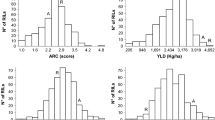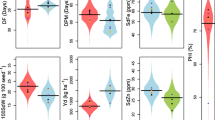Abstract
The common bean is an important legume worldwide. The aim of this study was to identify quantitative trait loci (QTLs) associated with seed and pod phenotypes and to evaluate the consistency of these QTLs across different environments and genetic backgrounds. Two nested recombinant inbred populations obtained from the crosses “Xana”/ “Cornell 4924” (XC) and “Xana”/ “BAT93” (XB) were used. The populations were phenotyped with respect to pod and seed size and number of seeds per pod and seed weight over two (XB) or five seasons (XC) using a randomized complete block design. The XC population was re-genotyped, and an updated linkage map, with 732 markers and a total length of 1390 cM, was developed. The XB population was genotyped using genotyping by sequencing (GBS), and the corresponding genetic linkage map consisted of 497 single-nucleotide polymorphisms (SNPs) with a total length of 1547 cM. Altogether, 13 and 18 QTLs for pod traits and 21 and 25 QTLs for seed traits were detected in the XC and XB populations, respectively. In addition, 20 and 27 significant epistatic interactions between QTLs were detected in the XC and XB populations, respectively. The overlap among identified QTLs in the two nested populations was also investigated. Results revealed four overlapping regions for pod traits and eight for seed traits between the XC and XB populations. QTLs for seed or pod phenotypes detected on telomeric genomic regions of chromosomes Pv01, Pv05, Pv06, Pv07, Pv08, and Pv11 overlapped with QTLs associated with pod or seed phenotypes previously reported in other studies. The results showed the complex architecture of the genetic control of the pod and seed phenotype and the use of the bean genome for the integration and validation of QTLs.



Similar content being viewed by others
Change history
17 July 2020
Unfortunately, in the final version of this article the original Table 6 was not included in the proofing step and the Table 5 was duplicated.
Abbreviations
- cM:
-
CentiMorgan
- GBS:
-
Genotyping by sequencing
- INDEL:
-
Insertion-deletion polymorphisms
- LG:
-
Linkage group
- LOD:
-
Logarithm of odds score
- Mb:
-
Megabase
- QTL:
-
Quantitative trait loci
- SCAR:
-
Sequence-characterized amplified regions
- SNP:
-
Single-nucleotide polymorphisms
- SSR:
-
Simple sequence repeat
- XB:
-
Xana/BAT93 recombinant inbred population
- XC:
-
Xana/Cornell recombinant inbred population
References
Adams MW (1967) Basis of yield component compensation in crop plants with special reference to the field bean, Phaseolus vulgaris. Crop Sci 7:505–510. https://doi.org/10.2135/cropsci19670011183X000700050030x
Bellucci E, Bitocchi E, Rau R, Rodriguez M, Biagetti E, Giardini A, Attene G, Nanni L, Papa R (2014) Genomics of origin, domestication and evolution of Phaseolus vulgaris. In: genomics of plant genetic resources. Editors: R Tuberosa, A Graner, E Frison. Pp 483-507. Springer Netherlands. https://doi.org/10.1007/978-94-007-7572-5_20
Blair MW, Iriarte G, Beebe S (2006) QTL analysis of yield traits in an advanced backcross population derived from a cultivated Andean x wild common bean (Phaseolus vulgaris L) cross. Theor Appl Genet 112:1149–1163. https://doi.org/10.1007/s00122-006-0217-2
Bradbury PJ, Zhang Z, Kroon DE, Casstevens TM, Ramdoss Y, Buckler ES (2007) TASSEL: software for association mapping of complex traits in diverse samples. Bioinformatics 23:2633–2635. https://doi.org/10.1093/bioinformatics/btm308
Brewer MT, Lang L, Fujimura K, Dujmovic N, Gray S, Knaap E (2006) Development of a controlled vocabulary and software application to analyze fruit shape variation in tomato and other plant species. Plant Physiol 141:15–25. https://doi.org/10.1104/pp106077867
Churchill GA, Doerge RW (1994) Empirical threshold values for quantitative trait mapping. Genetics 138(3):963–971
Cichy KA, Blair MW, Mendoza CHG, Snapp AA, Kelly J (2009) QTL analysis of root architecture traits and low phosphorus tolerance in an Andean bean population. Crop Sci 49:59–68. https://doi.org/10.2135/cropsci2008030142
R Core Team (2018) The R project for statistical computing. Available at: wwwR-projectorg/ Accessed: September 2018
Correa da Silva L, de Souza TLP O, Damiao Cruz C et al (2018) Linkage fine-mapping and QTLs affecting morpho-agronomic traits of a Mesoamerican x Andean RIL common bean population. Euphytica 214:221. https://doi.org/10.1007/s10681-018-2299-8
Coyne DP (1968) Correlation, heritability and selection of yield components in field beans, Phaseolus vulgaris L. Proc Am Soc Hortic Sci 93:388–396
Doerge RW (1996) Constructing genetic maps by rapid chain delineation. J Quant Trait Loci 2:121–132
Doyle JJ, Doyle LH (1990) Isolation of plant DNA from fresh tissue. Focus 12:13–15
Elshire RJ, Glaubitz JC, Sun Q, Poland JA, Kawamoto K, Buckler ES, Mitchell SE (2011) A robust, simple genotyping-by-sequencing (GBS) approach for high diversity species. PLoS One 6:e19379. https://doi.org/10.1371/journalpone0019379
FAOSTAT (2018) FAOSTAT statistics database http://wwwfaoorg/faostat/en/#home
Fragoso AC, Moreno M, Wang Z, Heffelfinger C, Arbelaez LJ, Aguirre JA et al (2017) Genetic architecture of a rice nested association mapping population. G3 (Bethesda) 7(6):1913–1926. https://doi.org/10.1534/g3117041608
Freyre R, Skroch PW, Geffroy V, Adam-Blondon AF, Shirmohamadali A, Johnson WC (1998) Towards an integrated linkage map of common bean 4 development of a core linkage map and alignment of RFLP maps. Theor Appl Genet 97:847–856. https://doi.org/10.1007/s001220050964
Gepts P, Osborne TC, Rashka K, Bliss FA (1986) Electrophoretic analysis of phaseolin protein variability in wild forms and landraces of the common bean Phaseolus vulgaris L: evidence for two centers of domestications. Econ Bot 40:451–468. https://doi.org/10.1007/BF02859660
González AM, Yuste-Lisbona FJ, Saburido S, Bretones S, Ron AM, Lozano R, Santalla M (2016) Major contribution of flowering time and vegetative growth to plant production in common bean as deduced from a comparative genetic mapping. Front Plant Sci 7:1940. https://doi.org/10.3389/fpls201601940
Hagerty CH, Cuesta-Marcos A, Cregan A, Song Q, McClean P, Myers JR (2016) Mapping snap bean pod and color traits, in a dry bean x snap bean recombinant inbred population. J Amer Soc Hort Sci 141(2):131–138
Hart J, Griffiths PD (2013) A series of eIF4E alleles at the Bc-3 locus are associated with recessive resistance to clover yellow vein virus in common bean. Theor Appl Genet 126:2849–2863. https://doi.org/10.1007/s00122-013-2176-8
Johnson WC, Gepts P (2002) The role of epistasis in controlling seed yield and other agronomic traits in an Andean × Mesoamerican cross of common bean (Phaseolus vulgaris L). Euphytica 125:69–79. https://doi.org/10.1023/a101577582
Kwak M, Gepts P (2009) Structure of genetic diversity in the two major gene pools of common bean (Phaseolus vulgaris L, Fabaceae). Theor Appl gent 118(5):979–992. https://doi.org/10.1007/s00122-008-0955-4
Kwak M, Velasco D, Gepts P (2008) Mapping homologous sequences for determinacy and photoperiod sensitivity in common bean (Phaseolus vulgaris). J Hered 99(3):283–291. https://doi.org/10.1093/jhered/esn005
Mamidi S, Rossi M, Moghaddam SM, Annam D, Lee R, Papa R, PE MC (2013) Demographic factors shaped diversity in the two gene pools of wild common bean Phaseolus vulgaris L. Heredity 110(3):267–276. https://doi.org/10.1038/hdy201282
Margarido GRA, Souza AP, Garcia AF (2007) OneMap: software for genetic mapping in outcrossing species. Hereditas 144:7879. https://doi.org/10.1111/j20070018-066102000x
McClean PE, Bett KE, Stonehouse R, Lee R, Pflieger S, Moghaddam SM, Geffroy V, Miklas PN, Mamidi S (2018) White seed color in common bean (Phaseolus vulgaris) results from convergent evolution in the P (pigment) gene. New Phytol 219(3):1112–1123
McMullen MD, Kresovich S, Villeda HS, Bradbury P, Li H, Sun Q, Flint-Garcia S et al (2009) Genetic properties of the maize nested association mapping population. Science 325(5941):737–740. https://doi.org/10.1126/science1174320
Miklas PN, Porch T (2010) Guidelines for common bean QTL nomenclature. Annu Rep Bean Improv Coop 53:202–204
Moghaddam SM, Song Q, Mamidi S, Schmutz J, Lee R, Cregan P, Osorno JM, McClean PE (2014) Developing market class specific InDel markers from next generation sequence data in Phaseolus vulgaris L. Front Plant Sci 5:185. https://doi.org/10.3389/fpls201400185
Park SO, Coyne DP, Jung G, Skroch PW, Arnaud-Santana E, Steadman JR, Ariyarathne H, Nienhuis J (2000) Mapping QTL for seed size and shape traits in common bean. J Amer Soc Hort Sci 125(4):466–475
Pedrosa-Harand A, Porch T, Gepts P (2008) Standard nomenclature for common bean chromosomes and linkage groups. Ann Rep Bean Improv Coop 51:106–107
Pérez-Vega E, Pañeda A, Rodríguez-Suárez C, Campa A, Giraldez R, Ferreira JJ (2010) Mapping of QTLs for morpho-agronomic and seed quality traits in a RIL population of common bean (Phaseolus vulgaris L.). Theor Appl Genet 120:1365–1380. https://doi.org/10.1007/s00122-010-1261-5
Pérez-Vega E, Campa A, Trabanco N, Casañas F, Giraldez R, Ferreira JJ (2012) Linkage genetic map developed in the Xans/Cornell49242 RIL population: a review. Ann Rep Bean Improv Coop 55:19–20
Sandhu KS, You FM, Conner RL, Balasubramanian PM, Hou A (2018) Genetic analysis and QTL mapping of the seed hardness trait in a black common bean (Phaseolus vulgaris) recombinant inbred line (RIL) population. Mol Breed 38(3):–34. https://doi.org/10.1007/s00122-010-1261-5
Schmutz J, McClean PE, Mamidi S, Wu GA, Cannon SB, Grimwood J et al (2014) A reference genome for common bean and genome-wide analysis of dual domestications. Nat Genet 46:707–713. https://doi.org/10.1038/ng3008
Song Q, Jia G, Hyten DL, Jenkins J, Hwang E-Y, Schroeder SG et al (2015) SNP assay development for linkage map construction, anchoring whole genome sequence and other genetic and genomic applications in common bean. G3 Bethesda 5:2285–2290. https://doi.org/10.1534/g3115020594
Tanabata T, Shibaya T, Hori K, Ebana K, Yano M (2012) SmartGrain: high-throughput phenotyping software for measuring seed shape through image analysis. Plant Physiol 160(4):1871–1880. https://doi.org/10.1104/pp112205120
Tar’an B, Michaels TE, Pauls P (2002) Genetic mapping of agronomic traits in common bean. Crop Sci 42:544–556. https://doi.org/10.2135/cropsci20025440
Vlasova A, Capella-Gutiérrez S, Rendón-Anaya M, Hernández-Oñate M et al (2016) Genome and transcriptome analysis of the Mesoamerican common bean and the role of gene duplications in establishing tissue and temporal specialization of genes. Genome Biol 17:32. https://doi.org/10.1186/s13059-016-0883-6
Voysest O (2000) Mejoramiento genético del fríjol (Phaseolus vulgaris L). Legado de variedades de América latina 1930–1999. CIAT, Cali, p 195
Wang CS, Rutledge JJ, Gianola D (1994) Bayesian analysis of mixed linear models via Gibbs sampling with an application to litter size in Iberian pigs. Genet Sel Evol 26:91–115. https://doi.org/10.1186/1297-9686-26-2-91
Wickham H (2016) ggplot2: elegant graphics for data analysis. Springer-Verlag, New York, p 211
Yang J, Hu CC, Hu H, Yu RD, Xia Z, Ye XZ, Zhu J (2008) QTL network: mapping and visualizing genetic architecture of complex traits in experimental populations. Bioinformatics 24:721–723. https://doi.org/10.1093/bioinformatics/btm494
Yu Y, Ouyang Y, Yao W (2018) ShinyCircos: an R/shiny application for interactive creation of Circos plot. Bioinformatics 34:1229–1231. https://doi.org/10.1093/bioinformatics/btx763
Yuste-Lisbona FJ, González AM, Capel C, García-Alcázar M, Capel J, de Ron A, Santalla M, Lozano R (2014) Genetic variation underlaying pod size and color traits of common bean depends on quantitave trait loci with epistatic effects. Mol Breed 33:939–952. https://doi.org/10.1007/s11032-013-0008-9
Zeng ZB (1994) Precision mapping of quantitative trait loci. Genetics 136:1457–1468
Acknowledgments
Authors thank M. Bueno, J.A. Poladura, and F. Díaz for their technical assistance
Funding
This work was supported in part by grant AGL2017-87050-R of the Spanish Government. E. Murube (FPI-INIA) and A Campa (DR13-0222) are recipients of a salary from the Instituto de Investigación y Tecnología Agraria y Alimentaria (INIA, Spain) co-funding with European Regional Development’s Funds (FEDER).
Author information
Authors and Affiliations
Corresponding author
Ethics declarations
Conflict of interest
The authors declare that they have no conflict of interest.
Additional information
Publisher’s note
Springer Nature remains neutral with regard to jurisdictional claims in published maps and institutional affiliations.
Electronic supplementary material
ESM 1
(DOCX 775 kb)
Rights and permissions
About this article
Cite this article
Murube, E., Campa, A., Song, Q. et al. Toward validation of QTLs associated with pod and seed size in common bean using two nested recombinant inbred line populations. Mol Breeding 40, 7 (2020). https://doi.org/10.1007/s11032-019-1085-1
Received:
Accepted:
Published:
DOI: https://doi.org/10.1007/s11032-019-1085-1




